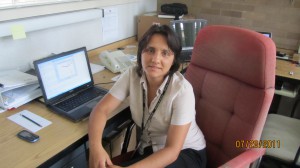Remote Sensing course
Viviana Vladutescu
NYCCT/CUNY
Have you ever found yourself looking up at the stars on a clear night and asking about the mysteries hiding up there? Have you ever wondered how with a pair of special goggles one can see in the night? Have you ever asked yourself how maps of the bottom of the ocean are created with so much accuracy, as if someone was actually there taking measurements? Have you ever been curious to find out how weather is predicted?
Answers to these questions and more alike can be found by understanding the remote sensing field interrelated with physics, engineering, chemistry and earth sciences. Being so interdisciplinary, the Remote Sensing course is suitable to students in Engineering, Environmental Sciences, Chemistry and Physics.
The Remote Sensing course offered at NYCCT/CUNY is meant to give you a clear understanding of the interaction of matter with radiation, instrumentation used to detect it and its applications. The remote sensors you will learn about in this course can be classified as passive and active. The passive sensors detect emitted radiation by different sources without interacting with them (i.e. the eye). On the other hand the active remote sensors send out radiation which is further detected after the interaction with the matter. Understanding these principles in detail will allow one to take this information to the next level and retrieve properties of the matter. These properties can be used in models and simulations. Here the lab work you will be doing as part of the course comes in handy. During the lab hours you will not only collect measurements using remote sensors but you will also learn how to interpret the data collected.
Now I would like to give a message to those of you taking this class with me or are interested in taking it: I always wanted my students to be the best in their fields and not just some average technicians, engineers, instructors or scientists. To accomplish that, one needs the right information: to be up to date with what is going on all over the world in one’s field and others (new scientific discoveries, new strategies, etc); to be a member of professional societies and keep up to date with the ongoing research in a particular field; and last but not least to check new announcements for internship opportunities, jobs and possible collaborations with others in this field. Considering this I urge you to pay close attention to the news on the sides of the page. Remote Sensing is a relatively new field, with new instruments and data reduction techniques being developed on a continuous basis globally.





% EET 3132:Remote Sensing, Instr: Viviana Vladutescu, Student: Antonio Aguirre
% Sept. 23, 2011 @ New York City College of Technology (CUNY)
% contact: sadykov1@yahoo.com
close all,clear all
%%% Showing a Blackbody radiation plot (lambda vs. blackbody radiation)
% Constants
h=6.626E-34; % Planck’s constant (J*s)
c=3E8; % speed of light (m/s)
k=1.38E-23; % Boltzmann’s constant (J/K)
sigma=5.67E-8; % Stefan–Boltzmann constant: http://en.wikipedia.org/wiki/Stefan%E2%80%93Boltzmann_constant
lambda=.001e-6:0.01e-6:20e-6; % Lambda in microns
T1=300; % Temperature of Earth in (K)
T2=6000; % Temperature of Sun in (K)
T3=5260; % Temperature of Alpha Centauri B in (K)
% Blackbody radiation equation in 3 parts: for simplicity
A1=(h*c)./(k*T1.*lambda);
A2=(h*c)./(k*T2.*lambda);
A3=(h*c)./(k*T3.*lambda);
B=(2*h*c^2)./lambda.^5;
BB1=pi.*(B.*(1./(exp(A1)-1)));
BB2=pi.*(B.*(1./(exp(A2)-1)));
BB3=pi.*(B.*(1./(exp(A3)-1)));
% Plot of the radiation curve for the Earth, Sun, and Alpha Centauri B.
subplot(2,1,1)
plot(lambda,BB1,lambda,BB2,lambda,BB3)
% semilogy(lambda,BB1,lambda,BB2,lambda,BB3)
xlabel(‘Wavelength in microns’)
ylabel(‘Radiance in W*m^-2’)
legend(‘earth bb’,’sun bb’,’alpha centaury’)
subplot(2,1,2)
plot(lambda,BB1)
% semilogy(lambda,BB1,lambda,BB2,lambda,BB3)
xlabel(‘Wavelength in microns’)
ylabel(‘Radiance in W*m^-2’)
legend(‘earth bb’)
%%% Showing that B(lambda,T)=sigma*T^4
display (‘B(lambda2,T2)=zz and sigma*T2^4=zz1’)
zz=trapz(BB2)
zz1=sigma*(T2^4)./0.01E-6